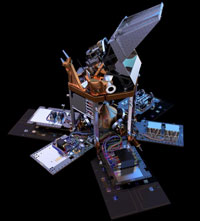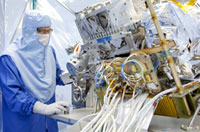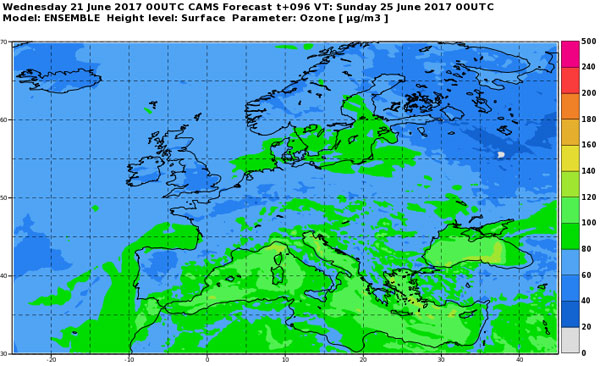A low Earth-orbiting satellite, the Copernicus Sentinel-5 Precursor (Sentinel-5P) mission is dedicated to monitoring the composition of the atmosphere. Its data will be used largely by the Copernicus Atmosphere Monitoring Service. The mission will deliver information to monitor air quality, stratospheric ozone and will also be used for climate variables monitoring, and support European policy-making.
A low Earth-orbiting satellite, the Copernicus Sentinel-5 Precursor (Sentinel-5P) mission is dedicated to monitoring the composition of the atmosphere. Its data will be used largely by the Copernicus Atmosphere Monitoring Service. The mission will deliver information to monitor air quality, stratospheric ozone and will also be used for climate variables monitoring, and support European policy-making.
The Sentinel-5P mission will be the first of a series of atmospheric chemistry missions to be launched within the European Commission's Copernicus programme. With the current launch window of September 2017 and a nominal lifetime of seven years, Sentinel-5P is expected to provide continuity in the availability of global atmospheric data products between its predecessor missions, SCIAMACHY (Envisat) and OMI (Aura), and the future Sentinel-4 and -5 missions.
It will carry a single payload, TROPOMI (TROPOspheric Monitoring Instrument), which is jointly developed by the Netherlands and ESA. Covering spectral channels in the UV, visible, near and short-wave infrared, it will measure various key species including tropospheric/stratospheric ozone, nitrogen dioxide, sulfur dioxide, carbon monoxide, methane, formaldehyde, as well as cloud and aerosol parameters.
Sentinel-5P will deliver unique data thanks to its enhanced spatial (for instance, 3.5 x 7 km), temporal (global coverage within 1 day) and spectral sampling (for instance, 0.1 nm) capabilities, compared to its predecessors. The temporal coverage will also guarantee an increase of cloud-free observations, to enable more high quality trace gas retrievals.
Sentinel-5P products will be used by Copernicus Services, namely the Atmosphere Monitoring Service (CAMS) or the Climate Change Service (C3S). These services will transform its data into high value information (for instance, forecasts of air pollution over Europe) that can be used by decision-makers to take appropriate actions on environmental policies, from which the well-being and security of EC citizens and future generations depend.
As well as serving the Copernicus Services, Sentinel-5P will also provide scientists with the possibility of using its spectra to develop new data products (for instance, fluorescence) and to extend existing satellite data records (such as ozone) to obtain better insight of atmospheric processes and dynamics (for instance, Brewer-Dobson circulation).
ESA's Sentinel-5P Mission Manager, Claus Zehner, says, "Air pollution harms human health and the environment, and is a local, pan-European and hemispheric issue. Air pollutants released in one country may be transported in the atmosphere, contributing to or resulting in poor air quality elsewhere.
"A satellite like the Sentinel-5 Precursor will complement local ground-based air quality networks by providing information about trans-boundary air pollution movement and will offer the means to make different worldwide ground-based air quality measurements inter-comparable."
About the Sentinels
The Sentinels are a fleet of dedicated EU-owned satellites, designed to deliver the wealth of data and imagery that are central to Europe's Copernicus environmental programme.
In partnership with EU Member States, the European Commission leads and coordinates this programme, to improve the management of the environment, safeguarding lives every day. ESA is in charge of the space component, responsible for developing the family of Copernicus Sentinel satellites and ensuring the flow of data for the Copernicus services, while the operations of the Sentinels have been entrusted to ESA and EUMETSAT.


